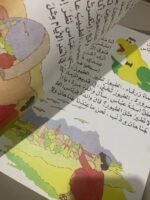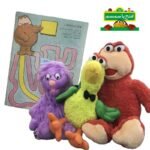Sold out






40.000 د.ك
Out of stock
Iftah Ya Simsim (Arabic: افتح يا سمسم) is the Arabic co-production of Sesame Street.
The series debuted in Kuwait in the fall of 1979, and was the first Sesame co-production in Arabic. There were 315 half-hour episodes produced in three seasons and broadcast on a weekday basis in various Arabic countries, before it returned to TV in 2015.
The original show featured Nu’man a full-body camel, Malsun, the (originally yellow-green) parrot, Yaqut, a female lavender monster with colorful bumps on her head and a long nose, and Abla, a full-body cat. For the show’s 2015 revival, Yaqut and Abla were dropped, and yellow monster girl Shams was introduced, along with Gargur (Grover) and several Aything Muppets, camels, cows,chickens, penguins and other birds that serve as side-characters.
The show’s title means “Open Sesame,” but the neighborhood itself in the original 1979 show was called Shari’ ‘lshrin (translated as “Twentieth Street”).
Key locations included a juice stand Khalil’s Refreshments, located at No. 8, and Hisham’s Shop, at No. 4, which sells newspapers.
The large house on No. 3 is the home of Hamad the engineer and his wife, Fatima the teacher.
Their next-door neighbor is Laila the nurse, and beyond is a small park. The park contains a playground, fountain, and garden, and attracts the local children.
The grandfatherly peddler Abdullah plies his trade there, selling toys, books, and games from his pushcart and regaling the kids with stories.
The Arab states of the Persian Gulf Joint Program Production Institution bought the co-production rights for a nine-year period in 1977.
The children’s television workshop provided technical assistance, research, and provided a consulting producer. As with other co-productions, CTW also supplied Muppet sketches, cartoons, and film inserts, which were then selected and dubbed into Arabic.
The studio “street” scenes were taped between May and December 1978. Although produced in Kuwait, much like the original version of Plaza Sesamo for Latin America, the series was intended for the entire Arab-speaking world, and the cast included a mixture of Kuwaitis, Saudi Arabians, Iraqis, Syrians, and children from twelve different Arab countries, including Algeria.
In 1989, a clip from the 141st episode was included in the special Sesame street:20 and still counting,
In 1990, during the Persian Gulf War, Iraqi forces invading Kuwait captured videotapes of the series and the Nu’man costume and brought them back to Iraq before being driven out by US forces. In 2003, Iraq was invaded by US forces but they have never been able to find the videotapes nor the Nu’man costume.
To this day, the video tapes and the Nu’man costume remain unrecovered.

Reviews
There are no reviews yet